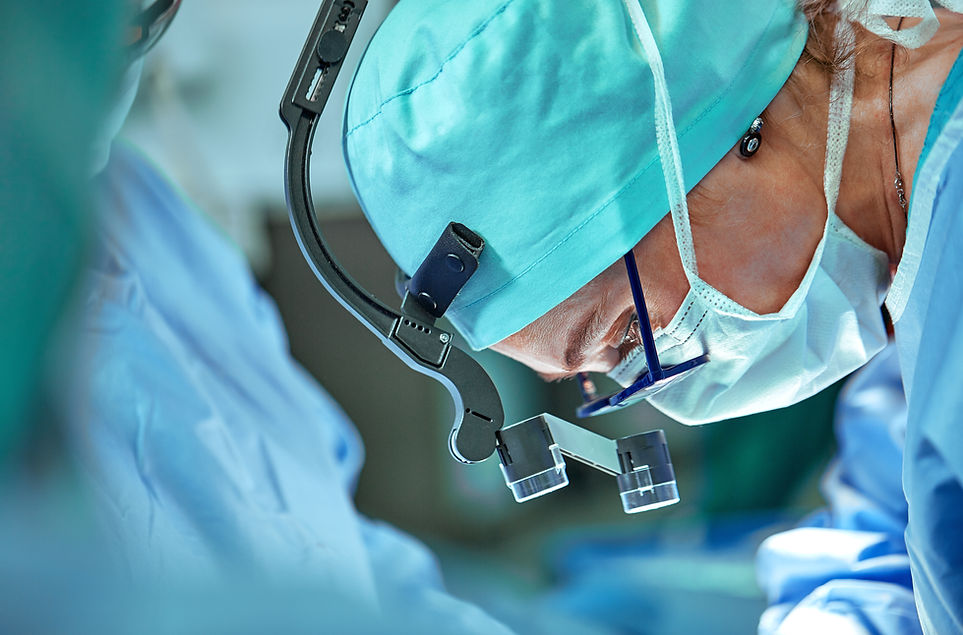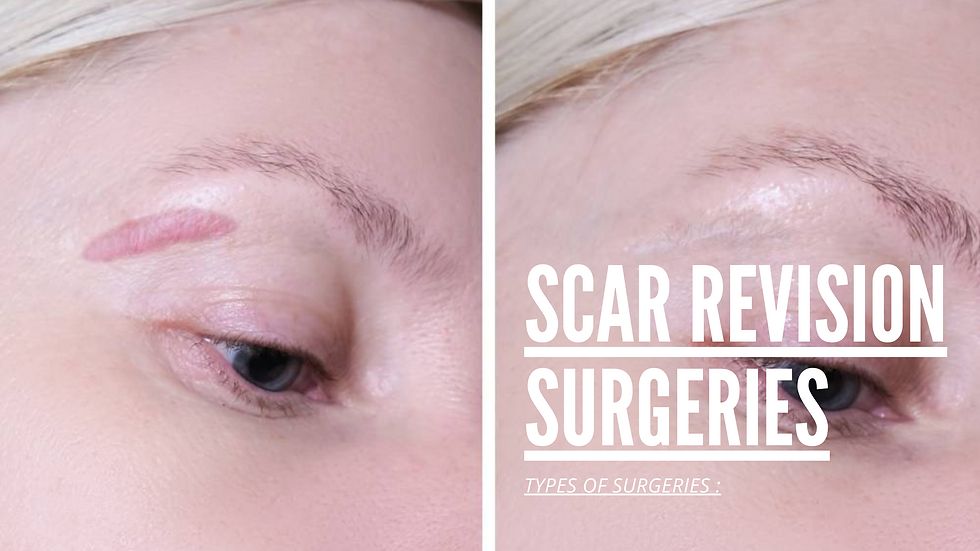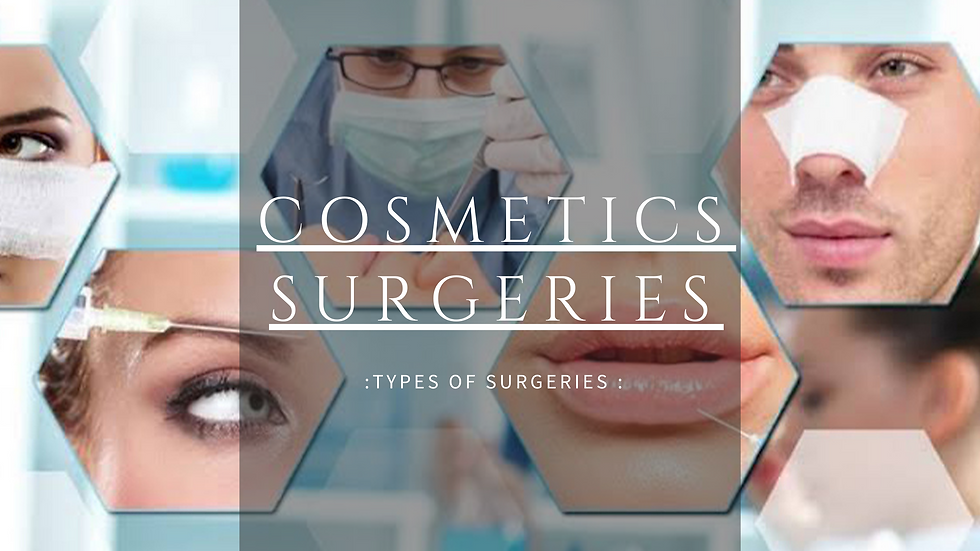: 8 TYPES OF SURGERIES:
- AMNA RAFIQ

- Sep 22, 2023
- 11 min read
Updated: Sep 23, 2023

Surgeries (or surgeries) are medical procedures that involve cutting into the body to repair or remove damaged or diseased tissue. They can be performed by surgeons, physicians, or other qualified medical professionals. Common surgeries include appendectomies, hysterectomies, joint replacements, and organ transplants. Depending on the type of surgery, recovery times can vary from days to months.
There are many different types of surgeries. Some surgeries are for medical reasons, while others are for cosmetic reasons. Some surgeries are more serious than others. Some surgeries are more common than others.
. TYPES OF SURGERIES:

There are many types of surgeries , each of them it's own specific purpose and method. Some of the most common types of surgeries include open surgery, endoscopic surgery, laparoscopic surgery, minimally invasive surgery, robotic surgery, and reconstructive surgery.
1. OPEN SURGERIES:

Open surgeries refer to procedures that involve making a large incision in the body in order to access the affected area. This type of surgery may require general anesthesia and typically requires a longer recovery time than minimally invasive procedures. Open surgeries have traditionally been used for complex medical conditions involving organs and tissues that are difficult to access. They are still commonly performed today, however, with advancements in technology and surgical techniques, many conditions can be treated with minimally invasive procedures, which offer benefits such as smaller incisions, reduced pain, and shorter recovery times.
2. Endoscopic surgery:

Endoscopic surgeries involve using a small camera and specialized instruments to perform a minimally invasive procedure through a small incision or natural opening in the body. These types of surgeries an be used for a variety of procedures, including diagnosing and treating conditions in the gastrointestinal tract, urinary system, and respiratory system. Benefits of endoscopic surgeries include less pain, fewer complications, faster recovery times, and reduced scarring compared to traditional open surgeries. However, not all conditions can be treated with an endoscopic approach, and patients should consult with their healthcare provider to determine which approach is best for their individual needs. involves the use of a thin, flexible tube to access and operate on internal organs.
3. Laparoscopic surgery :

Laparoscopic surgery, also known as minimally invasive surgery, is a modern surgical technique that involves making small incisions rather than large ones. A laparoscope, a small tube with a camera and light, is inserted through one of these incisions, enabling the surgeon to view the inside of the body on a monitor. Other instruments are inserted through additional small incisions, allowing the surgeon to perform the surgery. Laparoscopic surgery results in less pain, a shorter hospital stay, and a faster recovery time compared to traditional open surgery, making it a popular choice for many types of surgeries.
while robotic surgery involves the use of a robot to assist the surgeon in performing various surgical procedures. Reconstructive surgery is performed to restore the function and appearance of damaged or deformed tissue and can be performed on various parts of the body.
4. ORTHOPEDIC SURGERIES :

Orthopedic surgeries involve the treatment of conditions that affect the musculoskeletal system, including bones, joints, muscles, ligaments, and tendons. Common orthopedic surgeries include joint replacements for hips, knees, and shoulders, as well as procedures to repair damaged tendons, ligaments, and fractures. Spinal surgeries for conditions such as herniated discs and spinal stenosis are also common. Advancements in technology have led to minimally invasive techniques for many orthopedic surgeries, allowing for shorter recovery times and reduced pain. Orthopedic surgery is a rapidly evolving field, and new techniques and procedures are constantly being developed to improve patient outcomes.
5. NEURO SURGERIES:

Neurosurgeries are medical procedures that involve the nervous system, including the brain, spinal cord, and nerves. These surgeries are performed to treat a variety of conditions, including tumors, injuries ,infections, and chronic pain. Common neurosurgeries include brain tumor removal, spinal fusion, and deep brain stimulation. Surgeons use specialized tools and techniques to minimize risks and make precise incisions. After surgery, patients may require physical therapy and medication to manage pain and promote healing. While neurosurgeries are complex procedures, they offer the potential for significant improvements in quality of life for patients with nervous system disorders.
6. CARDIOVASCULAR SURGERIES:

Cardiovascular surgeries refer to surgical procedures performed on the heart or blood vessels. These surgeries aim to repair or treat conditions affecting the cardiovascular system, such as coronary artery disease, heart valve conditions, heart failure, and thoracic aortic aneurysms. Types of cardiovascular surgeries include coronary artery bypass grafting (CABG), valve replacement or repair, transplant, and congenital heart defect repairs. CABG involves taking a healthy blood vessel from another part of the body to bypass a blocked or narrowed coronary artery. Valve replacement or repair involves the replacement or repair of damaged heart valves. Transplant involves replacing a diseased heart with a healthy one. Congenital heart defect repairs are surgeries to correct heart malformations present at birth.
7. CARDIOTHORACIC SURGERIES:

Cardiothoracic surgeries is a type of procedure that involves the treatment of diseases of the heart, lungs, and other organs in the chest. They can be performed on patients of all ages, from newborns to the elderly. Common surgeries in this field include coronary artery bypass grafting (CABG), valve replacement, and repair of congenital heart defects. Other less common surgeries include lung resection, heart transplantation, and thoracic aortic aneurysm repair.
. CABG (CORONY ARTERY BYPASS GRAFTING ):

CABG is a surgical technique used to treat coronary artery disease (CAD). This procedure involves bypassing narrowed or blocked coronary arteries with a healthy blood vessel taken from another part of the body. The goal of this surgery to improve the blood flow to the heart and reduce the risk of future heart attack or stroke. During surgery, the chest is opened and the diseased artery is identified, then a healthy blood vessel is attached to the artery on either side of the blockage to restore normal blood flow.
.VALVE REPLACEMENT:

Valve replacement is a common procedure used to treat valve dysfunction in the heart. In this surgery, the damaged valve is replaced with a mechanical or bio-prosthetic valve. The new valve is carefully inserted to ensure that it functions properly and blood flow is not disrupted. Depending on the patient's condition, either open-heart surgery or minimally invasive techniques may be used.
. REPAIR OF CONGENITAL HEART DEFECT:

Surgeries to repair congenital heart defects involve correcting structural abnormalities in the heart and its supporting vessels. This type of surgery can often be performed using minimally invasive techniques. Congenital heart defects can include malformations of the heart valves, septum defects, and other heart defects. During the surgery, the abnormal structures are removed or repaired and the heart is reconstructed to restore normal function.
. LUNG RESECTION :

Lung resection is a procedure used to remove all or part of a diseased lung. It is often used to treat lung cancer or conditions such as tuberculosis, emphysema, and cystic fibrosis. During the surgery, the chest is opened and the affected part of the lung is identified and removed. The remaining healthy portion of the lung is then reattached to the windpipe and the chest is closed.
. Heart transplantation:

Heart transplantation is a procedure used to treat end-stage heart failure. The patient's diseased heart is replaced with a healthy donor heart. During the surgery, the chest is opened and the patient's heart is removed and replaced with the donor heart. The patient's blood vessels are then connected to the donor heart and the chest is closed.
. Thoracic aortic aneurysm
repair :

Thoracic aortic aneurysm repair is a surgery used to treat an aneurysm of the aorta, the main artery in the body. During the procedure, the chest is opened and the aneurysm is identified and repaired. The aneurysm may be repaired with a patch or replaced with a graft. The chest is then closed and the patient's recovery is monitored.
Cardiothoracic surgeries are complex and require advanced training and skills to perform. It is important to consult with a qualified specialist before undergoing any of these procedures as the risks and benefits of each surgery must be weighed carefully.
8. PLASTIC SURGERIES:

Plastic surgery is a medical specialty that involves the reconstruction, repair, or replacement of physical defected form or function involving the skin, musculoskeletal system, craniomaxillofacial structures, hand, extremities, breast, and trunk etc. It can be divided into two categories:
.TYPES OF PLASTIC SURGERIES:

.RECONSTRUCTIVE SURGERIES:
Reconstructive surgeries are a type of surgery that is used to restore the form and function of a body part, typically after an injury or illness. These surgeries are often used to repair and reconstruct damaged tissue, bone, and organs. Reconstructive surgeries can help improve the physical appearance of a person, correct birth defects, and improve a person's ability to function. Reconstructive surgeries are often complex and involve a team of surgeons and medical staff. Depending on the surgery, they may involve the use of a combination of surgical techniques, such as skin grafts, tissue flaps, and bone grafts. In addition to the surgery itself, reconstructive surgeries may involve follow-up care such as physical therapy, which can help a person regain strength and mobility. Reconstructive surgeries can help improve a person's quality of life and help them live a more normal and active lifestyle. which is aimed at correcting physical defects, and cosmetic or aesthetic surgery, which is aimed at improving appearance. Reconstructive procedures can be further divided into those that are primarily intended to improve function Common reconstructive procedures include breast reconstruction
.BREAST RECONSTRUCTIVE SUREGERIES:
Breast reconstructive surgery is a type of surgery that aims to rebuild a breast after a mastectomy or other type of surgery that involves the removal of all or part of the breast. This type of surgery can be done either immediately after the mastectomy, or at a later time. During the surgery, a plastic surgeon will use a variety of techniques to reconstruct the breast, including using implants, tissue from other parts of the body, or a combination of both. The goal of the surgery is to restore the natural appearance and shape of the breast while still providing the patient with a sense of comfort and confidence.
The type of breast reconstructive surgery that is right for a particular patient will depend on a variety of factors, including the patient’s body type, the amount of tissue that needs to be reconstructed, and any other medical conditions that may be present. During the consultation, the surgeon will discuss the different techniques available and which one would be best for the patient. Some of the techniques used in breast reconstructive surgery include tissue flaps, breast implants, and fat transfer.
In the case of tissue flaps, the surgeon will use tissue from another part of the body, such as the back or abdomen, to rebuild the breast. This type of surgery is relatively invasive and requires multiple incisions in order to remove the tissue and place it in the desired area. Breast implants is the artificial devices the are inserted into the chest to provide the patient with the desired shape and size. Finally, fat transfer is a technique that involves taking fat from one area of the body and injecting it into the breast area.
. CLEFT LIPS SURGERIES:
Cleft lips occur when a baby’s lip or mouth do not form properly during pregnancy. When a baby has a cleft lip, it can be very noticeable and can cause physical and emotional issues. Fortunately, cleft lip surgeries can help improve the appearance of the lip and improve the function of the mouth. The surgery typically involves separating the lip and then stitching it back together in a more normal position. It may also involve moving the muscles of the upper lip to help improve the appearance. Depending on the severity of the cleft, more than one surgery may be needed. During the surgery, the plastic surgeon will make an incision at the base of the nose and then cut down to the base of the upper lip. This area will be closed off, and the muscles of the upper lip will be brought together to make a smooth transition. The edges of the lip can be reshaped to match the contours of the face. After the surgery, the stitches will be removed and a healing period of several weeks may be necessary. Cleft lip surgery can help improve the appearance of the lip and the function of the mouth, allowing the patient to eat, speak, and smile normally.
. PLATE REPAIR SURGERIES :
Plate repair surgeries are a type of orthopedic surgery and are commonly used to repair fractures and other bone-related injuries. During the surgery, a metal plate is inserted into the bone to help stabilize and support it while it heals. This type of surgery is often used to repair fractures in the upper arm, lower arm, lower leg, and upper leg. It is also sometimes used to repair other types of bone injuries, such as those found in the wrist, shoulder, or ankle.
During the surgery, the metal plate is inserted into the bone to provide additional stability and support. The plate is attached to the bone using screws and can be customized to fit the specific fracture or injury. The screws are then tightened to secure the plate in place. The plate and screws are usually left in place to help support the bone as it heals. In some cases, additional hardware such as plates or pins may be used to help hold the bone in place.
After the surgery, the patient may need to wear a cast or splint to keep the fracture immobile while it heals. Physical therapy may also be needed to help restore strength and range of motion to the injured area. The amount of time it takes for the fracture to heal will depend on the severity of the injury and the type of plate used. In general, the goal of plate repair surgery is to provide the patient with a stronger and more stable bone structure.
. SCAR REVISION SURGERIES:
Scar revision is a treatment to minimize the appearance of a scar. It is used to improve the color, texture, and overall appearance of a scar so that it blends in with the surrounding skin. Scar revision is a common procedure that is performed to reduce the visibility of scars caused by injury, surgery, or acne. The goal of scar revision is to make the scar less noticeable, while still maintaining a natural look. The treatment can involve a variety of techniques such as dermabrasion, laser resurfacing, steroid injections, and skin grafting. Depending on the type of scar, the doctor may recommend a combination of treatments. Dermabrasion involves using a high-speed rotary wheel to gently sand away the top layer of skin. Laser resurfacing is a more advanced procedure in which a laser is used to remove the top layer of skin and stimulate new collagen production. Steroid injections are used to reduce the appearance of raised scars. Skin grafting involves using a piece of healthy skin to cover the scar. The doctor will determine the best treatment option to reduce the visibility of your scar. Scar revision can improve the appearance of a scar, although it is not possible to completely remove it. The results of scar revision will vary depending on the size, shape, and location of the scar.
.COSMETICS SURGERIES:
Cosmetic surgery is a type of plastic surgery that focuses on enhancing a person's appearance. It can be performed on any part of the body, including the face, neck, and breasts. There are a variety of procedures that can be done to improve a person's physical appearance. These include breast augmentation, liposuction, nose reshaping, face lifts, and eyelid surgery. Each of these procedures has its own risks and benefits, and should be considered carefully before undergoing any type of cosmetic surgery. The cost of cosmetic surgery varies depending on the type of procedure being performed and the location of the surgery. Recovery time also varies depending on the type of surgery performed. Generally, most cosmetic surgeries require a few weeks of recovery time. It is important to note that some risks, such as infection, are common after any type of surgery. It is also important to research the credentials of any doctor performing cosmetic surgery to ensure that they are properly trained and certified.
. CONCLUSION :
Surgery is a wide-ranging field, with a variety of different procedures used to address a variety of different medical needs. Whether a patient requires a hernia repair, a tonsillectomy, or a major organ transplant, surgery can provide life-saving care. Surgery has advanced significantly over the years, with improved technology leading to shorter recovery times and less invasive procedures. As a result, surgery is now used more frequently to treat a variety of medical conditions and can be a safe and effective form of treatment. Ultimately, by understanding the different types of surgeries available, patients and their families can make informed decisions about the best way to address their medical needs.










Comments